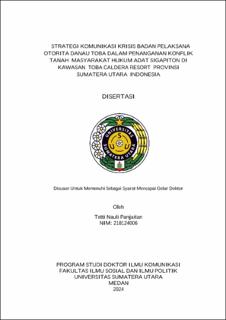| dc.description.abstract | This research aims to analyze the communication process of the Lake Toba Authority Board (BPODT) in handling the land conflict with the Sigapiton indigenous community, identify cultural elements influencing BPODT’S crisis communication strategy in handling the conflict, and determine BPODT’s crisis communication strategy in addressing the conflict with the Sigapiton indigenous community. The theories and concepts used for analysis include the symbolic interactionist perspective, elem!ents of Corporate Social Responsibility Communication, Hofstede’s cultural dimension theory and crisis communication theory. A qualitative method with a social definition paradigm was employed. Data collection techniques included observation and in-depth interviews. Research informants consisted of one BPODT public relations officer, three members of the Sigapiton indigenous community, and one local government official. The data obtained by the researcher reached saturation. Data triangulation involved one BPODT director, three members of the Sigapiton indigenous community, one human rights center head, one cultural expert, and one public relations expert. The findings indicate that the communication process between BPODT and the community led to conflict, with BPODT’s messages perceived as coercive, evoking strong emotions within the community. The Sigapiton indigenous community, characterized by a collectivist culture with high-context communication styles, holds unique values, norms, principles, and beliefs. These cultural elements should be the basis for communication approaches in conflict resolution. BPODT employed a crisis communication denial strategy, which involves denying the occurrence of a crisis. The researcher identified an alternative crisis communication strategy, ”Dalihan na Tolu, “ based on Hofstede’s cultural perspective for resolving the land conflict with the Sigapiton indigenous community. | en_US |


